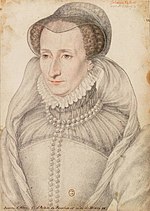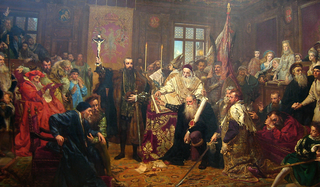
Year 1569 (MDLXIX) was a common year starting on Saturday of the Julian calendar.

Henry IV, also known by the epithets Good King Henry or Henry the Great, was King of Navarre from 1572 and King of France from 1589 to 1610. He was the first monarch of France from the House of Bourbon, a cadet branch of the Capetian dynasty. He pragmatically balanced the interests of the Catholic and Protestant parties in France as well as among the European states. He was assassinated in 1610 by a Catholic zealot, and was succeeded by his son Louis XIII.

The French Wars of Religion refers to the period of civil war between French Catholics and Protestants from 1562 to 1598. Between two and four million people died from violence, famine or disease directly caused by the conflict, and it severely damaged the power of the French monarchy. One of its most notorious episodes was the St. Bartholomew's Day massacre in 1572. The fighting ended with a compromise in 1598, when Henry of Navarre, who had converted to Catholicism in 1593, was proclaimed King Henry IV of France and issued the Edict of Nantes, which granted substantial rights and freedoms to the Huguenots. However, Catholics continued to disapprove of Protestants and of Henry, and his assassination in 1610 triggered a fresh round of Huguenot rebellions in the 1620s.

The House of Albret, which derives its name from the lordship (seigneurie) of Albret (Labrit), situated in the Landes, was one of the most powerful feudal families of France and Navarre during the Middle Ages.

Antoine de Bourbon, roi de Navarre was the King of Navarre through his marriage to Queen Jeanne III, from 1555 until his death. He was the first monarch of the House of Bourbon, of which he was head from 1537. Despite being first prince of the blood, Antoine was dominated by king Henry II's favourites, the Montmorency and Guise families, in regards to political influence. When Henri died in 1559, Antoine found himself sidelined in the Guise-dominated government, and then compromised by his brother's treason. When Francis in turn died he returned to the centre of politics, becoming Lieutenant-General of France, and leading the army of the crown in the first of the French Wars of Religion. He died of wounds sustained during the Siege of Rouen. He was the father of Henry IV of France.
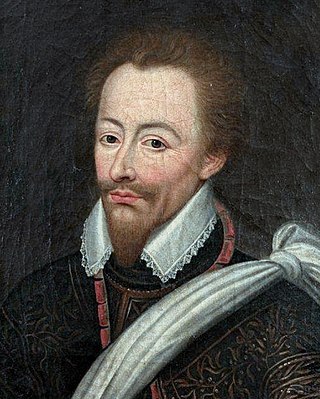
Henri I de Bourbon, Prince of Condé was a French prince du sang and Huguenot general like his more prominent father, Louis I, Prince of Condé.
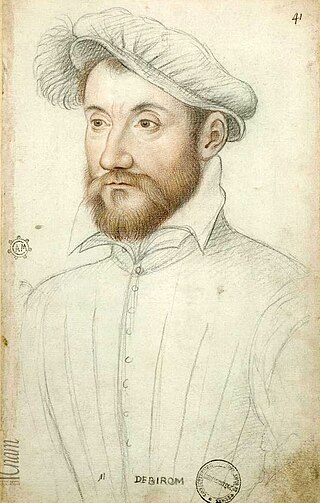
Armand de Gontaut, Baron of Biron was a soldier, diplomat and Marshal of France. Beginning his service during the Italian Wars, Biron served in Italy under Marshal Brissac and Guise in 1557 before rising to command his own cavalry regiment. Returning to France with the Peace of Cateau-Cambresis he took up his duties in Guyenne, where he observed the deteriorating religious situation that was soon to devolve into the French Wars of Religion. He fought at the Battle of Dreux in the first civil war. In the peace that followed he attempted to enforce the terms on the rebellious governorship of Provence.

Orthez is a commune in the Pyrénées-Atlantiques department, and region of New Aquitaine, southwestern France.

The Peace of Saint-Germain-en-Laye was signed on 8 August 1570 by Charles IX of France, Gaspard II de Coligny and Jeanne d'Albret, and ended the 1568 to 1570 Third Civil War, part of the French Wars of Religion.

The ruins of the Château de Bellocq are in the commune of Bellocq in the Pyrénées-Atlantiques département of France.

Catherine of Bourbon was a Navarrese regent princess. She was the daughter of Queen Jeanne d'Albret and King Antoine of Navarre. She ruled the principality of Béarn in the name of her brother, King Henry III of Navarre, from 1576 until 1596.

The Château de Nérac is a castle in the Lot-et-Garonne département in southwest France. An edifice of the French Renaissance style, it was finished during the reign of Jeanne d'Albret, Queen of Navarre, daughter of Marguerite d'Angoulème who was also Marguerite de Navarre by her marriage to Henry II of Navarre.
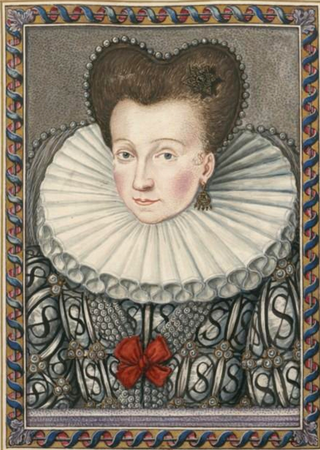
Françoise d'Orléans-Longueville was the second wife of Louis de Bourbon, Prince of Condé, a "Prince du Sang" and leader of the Huguenots during the French Wars of Religion.

Jeanne d'Albret, also known as Jeanne III, was Queen of Navarre from 1555 to 1572.
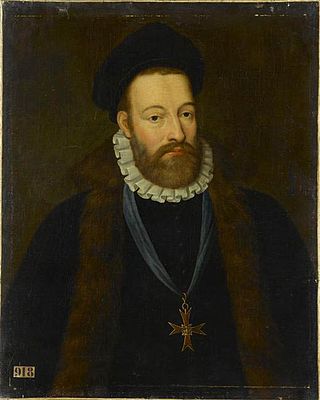
Honorat de Savoie, marquis of Villars was a marshal of France and admiral of France. Born into a cadet branch of the house of Savoy, he fought for first Francis I, and then Henri II during the Italian Wars. This included fighting at Hesdin and the battle of Saint-Quentin. During this period he also conducted diplomacy for the French court, and was involved in the negotiations that brought an end to the Italian Wars. Subsequently, he received the office of lieutenant-general of Languedoc, in which he suppressed Huguenots for several years before resigning the commission in 1562.
Events from the year 1572 in France.
Jean de Laforcade, Seigneur de La Fitte, aka Jean Laforcade, Seigneur de Lafitte, aka Jean Lafourcade, aka Jean II. de Forcade, was a Protestant nobleman and a descendant of the noble family of Forcade of Béarn in Navarre.
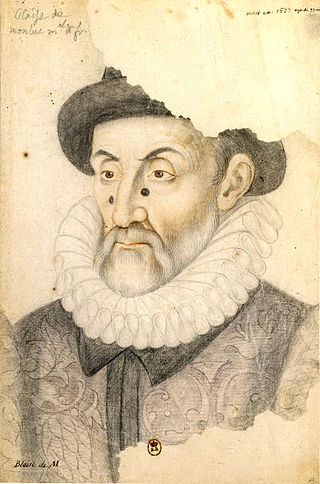
The Battle of Vergt took place on 9 October 1562 in the early stages of the French Wars of Religion, between a Royalist army led by Blaise de Montluc and Huguenot rebels under Symphorien de Duras. The battle was a decisive Royalist victory, which destroyed Duras' army, and prevented him reinforcing Protestant forces in the Loire Valley led by Gaspard II de Coligny and Condé. As such, it is considered a turning point in the first French War of Religion.

Antoine I d'Aure de Gramont, viscount of Aure, count of Guiche, sovereign-lord of Bidache was a French courtier and general. He served as gentleman in ordinary to the king's chamber from 1559 to 1564, serving Henry II, Francis II and Charles IX in that role.

Charles de Coucis seigneur de Burie (1492-1565) was a Catholic military commander and lieutenant-general of Guyenne. Burie assisted the crown in its efforts to extinguish the embers of the Conspiracy of Amboise in 1560, investigating the situation in Poitiers for the court. This accomplished he returned to his lieutenant-generalship where he spent the next year attempting to suppress the Huguenots of the region. A moderate figure, he looked to find compromise as far as toleration of Protestantism was concerned, conceding the right of Protestants to hold their services in private, and seeking to provide them the right to bury their dead in their own cemetery.

